Latest News
February 1, 2012
By Mark Clarkson
As the recent failure of Russia’s Phobos-Grunt probe highlights, it’s tough to get to Mars. Even NASA has only a 65% success rate with Mars missions.
It’s not just the mechanics of the vehicles, themselves. Sure, a Mars rover is a fantastically complex machine with tons of onboard computers, instruments and sensors, but so is a Cadillac CTS-V or a Boeing 777. A Mars rover does, however, present some unique challenges.
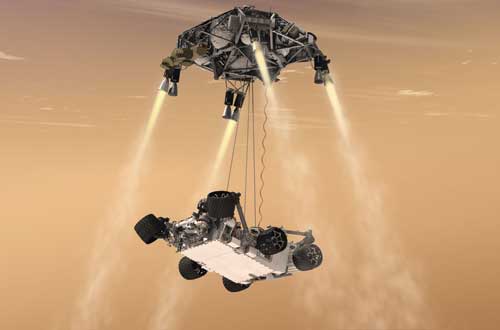
Artist rendering of the sky crane maneuver.
Image courtesy NASA/JPL-Caltech.
Most manufacturers have the advantage of being able to replace a part if something goes bad. They can issue a recall, or just recommend replacing your car’s oil filter during normal servicing.
“We don’t have those kind of luxuries,” notes Bill Allen, mechanical design engineer at NASA’s Jet Propulsion Laboratory (JPL), Pasadena, CA. “We don’t get a chance to retry or rebuild or service or redesign. We have one shot—and it’s usually doing something we’ve never done before. We’re trying to use existing tools and processes to get us through a unique design.”
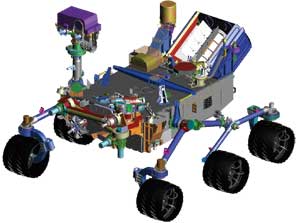 A 3D CAD rendering of the MSL rover in fully-deployed ‘traverse’ mode. Different systems are color coded. |
A World Apart
Those unique designs must face uniquely challenging environments. Sure, there’s a temperature difference between Oslo in the winter and Phoenix in the summer, but that’s just peanuts to space.
“When you’re dealing with Earth-based development, you just don’t have the range of dynamic and thermal loads that something that’s expected to leave our planet and land on another planet is going to experience,” says JPL’s Art Avila. “We have to balance risk, cost, volume ]and mass] in a different trade space than one would with a car or a plane.”
Case in point: The Mars Science Laboratory (MSL), NASA’s latest Mars rover, due to arrive at Mars this August.
Avila, a 27-year veteran of JPL, was the manager of the MSL’s Thermal and Cryogenic Engineering Section. They created the thermal control system for the rover, which maintains all the vehicle’s components within their specified temperature ranges, during all parts of the mission.
“You have to accommodate ground operations here at the Cape,” says Avila, “and the ascent portion, which has a whole host of environmental conditions—free molecular heating, depressurization, things that cause the temperature to change either rapidly or slowly on the vehicle. Then, of course, the cruise to Mars, out in deep space.”
And the really tricky part is yet to come.
Entry, Descent, Landing
MSL will have spent eight-and-a-half months in a hard vacuum, drifting through the utter cold of deep space. Then the challenge becomes to keep it warm. Now it hits the Martian atmosphere. The ablative heat shield reaches temperatures in excess of 2,700 ° F. The G loads and vibration are even worse than those during launch.
Once the vehicle slows down to around Mach 2, a parachute deploys and the heat shield is jettisoned, exposing the rover and the descent stage to the frigid carbon dioxide (CO2) winds of Mars’ upper atmosphere. After a plunge through a fiery inferno, the craft is now convectively cooled as it descends beneath its parachute.
Next, the backshell and parachute are jettisoned and the descent stage fires its rockets. Too massive for the airbag-style landing employed by the Mars Exploration Rovers, the MSL rover itself is lowered from the descent stage on an improbable arrangement of cables. When the rover touches down, the cables separate and the descent stage flies away to crash, leaving the rover on the Martian surface, ready to deploy.
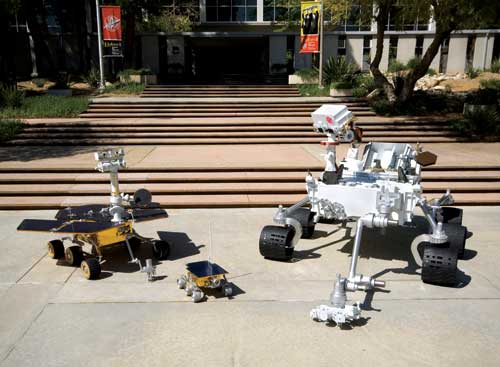
A family portrait of JPL’s Mars rovers. Mars Exploration Rover (left)
launched June-July 2003; Mars Pathfinder (center) launched December 1996;
and Mars Science Lab (right) launched November 2011.
Consider: Less than 20 minutes have passed since the rover was in free fall, in a vacuum, in outer space. Leaving aside for the moment the staggering mechanical complexities of carrying out this phase, the sheer range of environments the rover has been through in the short intervening time—vacuum, re-pressurization, wind, vibration, noise, gee loads, scorching heat, freezing cold—is mind-boggling.
“It’s an interesting combination of contrasting environments,” says Avila. “It makes this not only challenging to design, but also very challenging to verify and validate the performance.”
Validating the Model
To validate those designs, the rover is dropped from cranes, shaken on shaker tables, exposed to a vacuum and baked under artificial suns to thoroughly test its components.
Testing for the deep space cruise phase occurs in a vacuum chamber chilled to -292 ° F. The Martian surface can’t be simulated nearly as well—Mars’ 38% of Earth’s normal gravity is a real showstopper—but JPL does the best it can. The rover goes into a large chamber with an 8 torr CO2 atmosphere, a cold floor and walls to simulate the Martian surface and sky, and a solar simulator beaming down.
“We put it through some very controlled thermal stress tests,” says Avila. “We get temperatures, pressure and the measure of irradiance when we’re using our solar simulator. The rover has its own flight sensors, and we augment those with several hundred test temperature sensors to give us all the additional detail that we need to understand how the system behaves within that test chamber.”
The results are carefully monitored and fed back into the all-important computer models of the rover, developed in Siemens PLM Software’s NX tool.
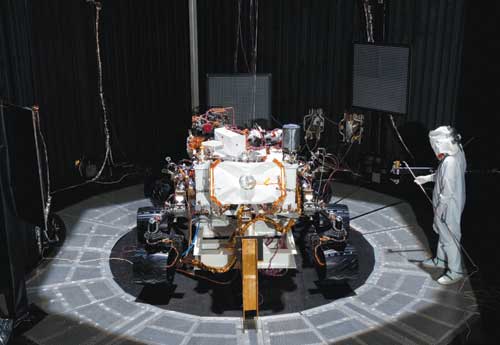
A heavily-monitored MSL rover undergoing thermal stress tests.
The sealed chamber simulates the Martian atmosphere, solar radiation,
and the sucking cold of the Martian ground and sky.
“Once we get good agreement with our mathematical models,” says Avila, “we feel very positive that we can simulate those things that we can’t test on the ground. We do the appropriate thermal magic to it, and that becomes our analysis thermal model.”
“We are very excited to contribute to JPL by implementing NX suite of CAD/CAM/CAE and Teamcenter software on the Mars Rover project,” said Jon Heidorn, vice president of marketing, Siemens PLM Software Americas. “NX successfully helps JPL create the geometry and generate the thermal model, while Teamcenter efficiently captures and maintains the design data. That allows much quicker integration of new design features into their CAE environment to update their models and perform analyses quickly.”
This model undergoes continuous revision, as the project moves from design studies to validation and testing and, eventually, the mission itself. It’s being used right now for flight operations. It will also provide valuable, hard-won knowledge for future missions.
Now, Where Did I Put That Thruster?
“During the whole development of the Mars program,” says Avila, “from the time of Mars Pathfinder in the mid ’90s, we were demonstrating certain technologies and design approaches, exercising them, and then infusing them into the next mission.
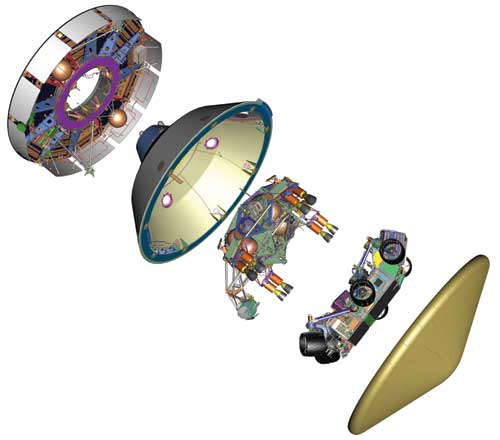
A CAD rendering of the MSL showing (from top to bottom) cruise stage,
backshell, descent stage, rover, and heat shield.
Because some of the team’s projects are highly dependent on upstream and downstream data consumption, Avila says, it “became clear that we had to be very careful about how data is transferred, translated and configuration managed. Mistakes occur when people are pushing pencils in that environment. With a seamless architecture, more software-to-software interfaces, you have better control of the delivery and receipt of data—and hopefully we minimize the ‘gotchas.’”
With JPL’s current approach to modeling, he explains, “We were able to capture the entire MSL mission. For future missions, we’re able to pull out a lot of designs or design features: a thruster or particular heat rejection system. We have all of that now in a managed database, and that’s what’s really going to help us in terms of efficiency, configure management and knowledge retention.”
Smoothly Centralized?
So, is JPL’s software all seamlessly integrated now?
“I’d like to tell you, ‘Yes,’” Allen says with a laugh. “Centralizing is a goal, but it’s always a challenge. We’re fairly well centralized, especially within the mechanical environment.”
On Siemens tools, for enterprise activity, JPL is moving from Teamcenter Enterprise to Teamcenter Unified Architecture, which is used for JPL’s mechanical engineering data management.
“But you have different fiefdoms within your organization that use different tools for different reasons,” Allen explains. “It might be a specialty task where they need a special tool. And it’s a moving target: What was best yesterday may not be best today.”
JPL, fortunately, is good at dealing with changing environments.
Contributing Editor Mark Clarkson is DE’s expert in visualization, computer animation, and graphics. His newest book is “Photoshop Elements by Example.” Visit him on the web at markclarkson.com or send e-mail about this article to [email protected].
Subscribe to our FREE magazine, FREE email newsletters or both!
Latest News
About the Author
Mark ClarksonContributing Editor Mark Clarkson is Digital Engineering’s expert in visualization, computer animation, and graphics. His newest book is Photoshop Elements by Example. Visit him on the web at MarkClarkson.com or send e-mail about this article to [email protected].
Follow DE




